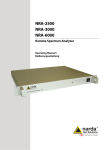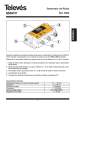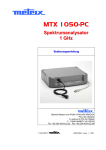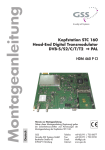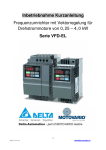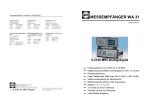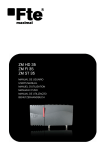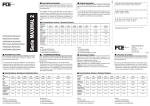Download Ref. 5930
Transcript
ore um o r iR at ed er 0 tor G e n a 93 r ne e .5 Ge o i s R e f N B 0d Hz M ON 96 47 23 0 7 1 2 5 6 0 3 4 0 -1 dB -3 9 8 -2 . dx lA ve Le 50 .1 5 Ref. 5930 Art.Nr. RG2150 ES EN IT DE Generador de Ruido Noise generator Generatore di Rumore Rauschgenerator Manual de Instrucciones User´s Manual Manuale del’Utente Bedienungsanleitung w w w. t e l e v e s . c o m 3 ES EN NOTAS SOBRE SEGURIDAD SAFETY PRECAUTIONS Antes de manipular el equipo, leer el manual de utilización y muy especialmente el apartado PRESCRIPCIONES DE SEGURIDAD. Before using the equipment, read the manual and pay particular attention to the SAFETY MEASURES section. sobre el equipo significa: “CONEl símbolo SULTAR EL MANUAL DE UTILIZACIÓN”. on the equipment means: The symbol “CONSULT THE USER MANUAL”. This may also appear in the manual as a warning or caution symbol. Recuadros de ADVERTENCIAS Y PRECAUCIONES pueden aparecer a lo largo de este manuapara evitar riesgos de accidentes a personas o daños al equipo u otras propiedades. WARNING and CAUTION messages may appear in this manual in order to avoid the risk of accidents or to avoid causing damage to the equipment or to other property. Prescripciones de Seguridad Safety measures • El uso del equipo de forma no especificada no asegura la protección del mismo. • Utilizar el equipo solamente en sistemas o instalaciones con el negativo de medida conectado a potencial de tierra. • Este equipo puede ser utilizado en instalaciones con Categoría de Sobretensión I y ambientescon Grado de Polución 2. • Tener siempre en cuenta los márgenes especificados tanto para la alimentación como para a medida. • The non-specified use of the equipment does not ensure its safety. • This equipment should only be using in systems or installation connected to a supply line with the corresponding ground terminal. • This equipment can be used in installations with Overvoltage Category II and in environments with Pollution Degree 2. • Always take the specified margins into account both for the powering as well as for the measurements. Conservación y Mantenimiento Maintenance • El mantenimiento a efectuar por el usuario se limita a la limpieza del mismo, el resto de operaciones deben ser efectuadas por personal especializado en el mantenimiento de instrumentos. • No emplear para la limpieza productos a basede hidrocarburos aromáticos o disolventes, estos productos pueden dañar los materiales plásticos de la carcasa. • Limpiar la caja solamente con un trapo humedecido con agua y en caso de ser necesario con un poco de jabón aplicando de forma suave. Dejar secar completamente el aparato antes de volver a utilizarlo. • The user should only clean the equipment, the other maintenance work must be carried out by specialised personnel. • Do not use any cleaning products with aromatic hydrocarbons or solvents, these products can harm the plastic elements of the housing. • To clean the box, use a damp (with water) cloth only and if necessary, carefully use some soap. Let the equipment dry completely before using it again. Adaptador TDT de alta sensibilidad 5 4 IT DE NOTE PER LA SICUREZZA SICHERHEITSHINWEISE Prima di utilizzare il dispositivo leggere completamente il manuale di istruzioni e in particolare il capitolo NORME DI SICUREZZA. Lesen Sie die Sicherheitshinweise sorgfältig durch, bevor Sie das Gerät in Betrieb nehmen, vor allem die UNFALLVERHÜTUNGSVORSCHRIFTEN. sopra il dispositivo significa: Il simbolo “CONSULTARE IL MANUALE DI ISTRUZIONI”. In questo manuale può apparire anche come simbolo di precauzione o avvertenza. auf dem Gerät bedeutet: Das Symbol “BEDIENUNGSANLEITUNG NACHLESEN”. 4 3 ore um t o r di R r a re n e 30 rato G e 59 ne s e . e f G oi Re N x. Ad 1 el Riquadri di AVERTENZA E PRECAUZIONE possono essere presenti in questo manuale per evitare rischi di incidenti a persone o danni al prodotto o altri oggetti. 0d 2 0 7 5 6 0 ON ES 96 47 23 3 4 0 -1 dB 5 1 2 Unfallverhütungsvorschriften • L’uso del prodotto in maniera non conforme non assicura la protezione dello stesso. • Utilizar il prodotto solamente in sistemi o installazioni con il negativo di misura connesso a potenziale di terra. • Questo prodotto può essere utilizzato in installazioni con Categoria di Sovratensione I e in ambienti con Grado di Inquinamento 2. • Tenere sempre in conto i margini specificati tanto per la alimentazione come per le misure. • Der nicht bestimmungsmässigen Einsatz des Gerätes gefährtet Ihren Schutz. • Verwenden Sie das Gerät nur wenn die Anlage geerdet ist. • Das Gerät darf nur verwendet werden, wenn die Anlage der VDEVorgaben entspricht. • Die angegebenen Grenzparameter sind zwingend zu beachten. • Il mantenimento da parte dell’utilizzatore si limita alla pulizia del prodotto, il resto delle operazioni devono essere effettuate da personale specializzato. • Non utilizzare per la pulizia del prodotto sostanze a base di idrocarburi aromatici o solventi. Questi prodotti possono essere dannosi. • Pulire solo con uno straccio inumidito con acqua e dove sia necessario con poco sapone in maniera dolce. Asciugare completamente il dispositivo prima di riutilizzarlo nuovamente. 9 8 -2 -3 HINWEISE UND WARNUNGEN können überall in der Bedienungsanleitung auftreten um (Lebens-) Gefahren zu vermeiden. Norme di Sicurezza Conservazione e Mantenimento B v Le 50 .1 5 Hz M Reiningung und wartung • Überlassen Sie Wartungsarbeiten stets qualifiziertem Fachpersonal. Führen Sie nur die Reinigung des Gerätes durch. • Vermeiden Sie Lösungsmittel und sonstige Reinigungsmittel die die Kunstoffeteile des Gehäuses beschädigen können. • Benutzen Sie zur Reinigung ein trockenes Tuch und reinigen Sie lediglich die Oberfl äche. Öffnen Sie auf keinen Fall das Gerät. Dispositivo diseñado para realizar pruebas de atenuación y planicidad en instalaciones de SMATV y CATV, usándolo conjuntamente con un medidor de campo Televés. Dispone de un conmutador rotativo que permite variar el nivel de salida en 10 ± 2 dB en 10 pasos. Salida de señal normal. Entrada de corriente procedente de la instalación para la alimentación del simulador. 1 lida principal debe ser cargada. 3 4 5 Conmutador rotativo que permite variar 10 ± 2 dB el nivel de salida en ambos conectores. Led indicador de encendido. Conector para alimentar exteriormente el simulador mediante el adaptador DC. Salida atenuada 30dB respecto a la que se obtiene en 1. Si se utiliza la salida atenuada, la sa- 2 Características técnicas Alimentación (externa o a través del cable coaxial) Consumo Conector de salida Frecuencia 5930 12 ...... 18 V <=2W “F” hembra 5 - 2150 MHz Nivel de salida máximo 80 ± 3dBμV/3MHz Regulación nivel salida 0 - 10 dB Generador de Ruido 7 6 El generador de ruido se puede alimentar mediante un adaptador de red, o bien desde el medidor mediante el cable de RF. Para acceder al menú de alimentación de previos en el medidor de campo, se pueden seguir los siguientes pasos en el menú: Comprobación de una instalación Generador de ruido Generador ruido Noise Generator Señal antena o TV cable Ref. 5930 -30 dB Level Adx. 5 - 2.150 MHz 2 3 ON 8 7 9 0 1 6 5 4 0 - 10 dB 234796 CONFIG. MEDIDAS LNB y PREAMPLIF. LNB Mezclador Toma TV Entrada señal de medidor Comprobación de la central T03 Ref. 5930 Level Adx. 5 - 2.150 MHz 2 3 ON 8 7 9 0 1 6 5 4 0 - 10 dB Cuando se trabaja con el generador de ruido, se recomienda seleccionar en el medidor la medida de potencia. Generador de ruido Generador ruido Noise Generator -30 dB 234796 C55 C58 C61 C65-69 Ejemplos de utilización: A continuación se explican brevemente algunos ejemplos de las aplicaciones del generador de ruido: Toma TV .- Comprobación del estado de un tramo de cable antes de su instalación: PWR 1 C49 C52 C42 C61 C55 C58 C65-69 5086 Entrada señal de medidor - Conecte el generador de ruido al medidor. Observe que el espectro del ruido generado es prácticamente plano. Cuanto mayor sea la longitud del cable que vaya a comprobar, mayor debe ser la potencia que entregue el generador de ruido. A continuación se muestra una pequeña tabla con las potencias mínimas recomendadas en función de la longitud de cable a comprobar (se ha tomado como ejemplo el cable T100 -ref. 2141-). O bien, pulsar la tecla rápida Entonces se abrirá la ventana de Alimentación: 5498 Alimentación - Configure el medidor de campo en modo analizador, seleccione Full Span y seleccione la medida de potencia. Utilizando el generador de ruido y el medidor de campo podrá comprobar el estado de un tramo de cable antes de instalarlo. Metros de cable (T100) Mínima potencia de salida del generador de ruido (dBμV) 10 43 25 47 50 55 75 62 100 70 150 80 Seleccione en el medidor el nivel de referencia adecuado. Tome nota de la medida de potencia en varias frecuencias a lo largo de la banda terrestre, y a continuación hacer lo mismo en banda satélite. Asímismo debe tener en cuenta en ancho de banda y el filtro de resolución utilizados en la medida, ya que las medidas de potencia a la entrada y a la salida deben realizarse con los mismos valores de estos parámetros. En este ejemplo tomamos como referencia las siguientes frecuencias: Banda terrestre: 200, 500 e 800 MHz Banda satélite: 1000, 1750, 2150 MHz Las medidas de potencia para las frecuencias de referencia son (hechas con BW=8 MHz y RBW=250 KHzW): ES Generador de Ruido 9 8 Frecuencia (MHz) Potencia (dBμV) 200 80.0 500 78.5 800 78.9 1000 78.8 1750 2150 79.5 Frecuencia (MHz) Atenuación (dB/m) 82.5 200 0.08 6.8 500 0.12 10.2 En las especificaciones del cable utilizado aparecerán la atenuación por metro (dB/m) que sufre la señal. Dicha atenuación varía con la frecuencia, aumentando a medida que aumenta la frecuencia. En la siguiente imagen se puede observar la señal a la entrada (en banda terrestre): frecuencia correspondiente, es decir, para cada frecuencia la potencia medida debería ser: En este ejemplo se ha tomado como referencia el cable de interior/exterior T-100 (ref.2141), y una longitud de cable de 85 m. La atenuación total se calcula multiplicando la atenuación/m por la longitud del cable. 800 1000 0.15 0.18 12.75 15.3 0.24 20.4 2050 0.27 22.95 - Conecte el generador de ruido a un extremo del cable. - Conecte el medidor en el otro extremo del cable, configúrelo en modo espectro y seleccione “Full Span”. Podrá comprobar que el espectro de la señal recibida ya no es plano, sino que el nivel va disminuyendo a medida que aumenta la frecuencia, tal como se ve en la siguiente imagen: Banda Terrestre En el ejemplo las medidas de potencia de la señal a la salida del cable deberían ser las siguientes, aproximadamente: Atenuación total (dB) 1750 Banda Terrestre POTENCIAsalida = POTENCIAentrada - ATENUACIÓNTOT Banda Satélite - Compruebe que la potencia medida en el medidor en todas las frecuencias de referencia se corresponde con los teóricos según la longitud del cable y de los factores de atenuación de la .- Evaluación de pérdidas de la instalación de cualquier frecuencia comprendida entre 15 y 2150 MHz (ver las características del generador de ruido): 2 Frecuencia (MHz) Potencia (dBμV) 200 73.2 500 68.3 800 66.15 1000 63.5 1750 59.1 2150 59.55 Resulta muy útil para comprobar que la red de distribución llega sin pérdidas a todas las tomas de la instalación. Como ejemplo utilizaremos una sencilla instalación en una vivienda unifamiliar: ES Generador de Ruido 11 10 - Primero debemos seleccionar una serie de frecuencias de referencia y medir la potencia que entrega el generador en cada una de ellas (igual que en el ejemplo anterior). En este ejemplo seleccionamos las siguientes: Cable T100 Referencias 2141 214107 214105 2155 215503 2126 212601 215101 Banda Frecuencia (MHz) Banda Frecuencia (MHz) Cubierta exterior mat´l PVC PVC PVC PE PE PVC PVC PVC LSFH Retorno 20.00 BIV 471.25 mm 6,6 6,6 6,6 6,6 6,6 6,6 6,6 6,6 BI 55.25 BIV-BV 607.25 Diámetro exterior ømax. FM 99.00 BV 855.25 blanco blanco negro negro negro blanco blanco blanco si si si si si si si si mat´l Cu Cu Cu Cu Cu Cu Cu Cu % 20 20 20 20 20 27 27 14 Al +Pt +Al Cu +Pt BS-b 120.00 FI-1 950.00 BIII-1 175.25 FI-2 1350.00 BIII-2 274.25 FI-3 1750.00 DAB 210.00 FI-4 2150.00 Color de la cubierta Lámina antimigratoria Malla Res. conductor exterior A continuación se muestran las tablas con las especificaciones de cada uno de los elementos de la instalación: Repartidores Características técnicas 543501 Margen frec. MHz 5- 47 MHz Atenuación 47-862 MHz 4,5 5- 47 MHz 5,5 dB 47-862 MHz 950 - 2400 MHz 543702 543802 6,5 8 7 7,5 9 9,5 6,5 - 10 - 6,5 - 9,5 - 11 - 9 5 - 862 MHz >15 7 >17 >15 950 - 2400 MHz >15 >15 >15 >15 Corriente máx. V 40 mA 300 Cu +Pt Cu +Pt Cu +Pt >75 >75 >75 >75 >75 >75 >75 >75 Cu Cu Cu Cu Cu Cu Cu Cu Res. conductor central ohm/ Km 20 20 20 20 20 20 20 18 Diámetro cond. central ømax mm 1,13 1,13 1,13 1,13 1,13 1,13 1,13 1,12 Capacidad pF/m 55 55 55 55 55 56,5 56,5 55 m 100 250 100 100 250 100 250 100 200 MHz 0,08 0,08 0,08 0,08 0,08 0,08 0,08 0,07 500 MHz 0,12 0,12 0,12 0,12 0,12 0,13 0,13 0,12 800 MHz 0,15 0,15 0,15 0,15 0,15 0,16 0,16 0,15 1000 MHz 0,18 0,18 0,18 0,18 0,18 0,19 0,19 0,17 0,20 Rechazo entre salidas Tensión máx. Cu +Pt % 8,5 - Cu +Pt mat´l 9,5 9,5 .. 12 mat´l Al +Pt +Al Dieléctrico Blindaje (EN50117) Metros/embalaje 5-2400 3,5 950 - 2400 MHz Atenuación 543602 Composición de la lámina entre dieléctrico y malla Atenuaciones Lo primero que haremos será calcular las atenuaciones para todas las tomas. Para ello habrá que tener en cuenta los metros de cable que hay desde la cabecera hasta cada una de las tomas y los elementos pasivos (separadores y tomas). ES 0,21 0,21 0,21 0,21 0,21 0,22 0,22 1750 MHz 0,24 0,24 0,24 0,24 0,24 0,25 0,25 0,23 2050 MHz 0,27 0,27 0,27 0,27 0,27 0,28 0,28 0,25 2150 MHz 0,27 0,27 0,27 0,27 0,27 0,29 0,29 0,26 2300 MHz 0,28 0,28 0,28 0,28 0,28 0,30 0,30 0,27 1350 MHz dB/m Tomas finales Pérd. inserción typ (dB) Referencia 5226 Tipo TV-SAT MATV SAT-FI 5-862 MHz 950-2150 MHz --- --- Pérd. derivación typ (dB) Salida MATV SAT-FI 5-862 MHz 950-2150 MHz R/TV 0,6 --- SAT --- 1,5 Paso DC 24v@350 mA SAT IN Generador de Ruido 13 12 Calcularemos paso a paso, a modo de ejemplo las atenuaciones de la toma de la Habitación 2 de la 2ª planta: La atenuación total será: Atenuación repartidor_5435 + Atenuación Atenuacióncable + Atenuacióntoma Metros de cable T100 5+1+7 = 13 metros de cable Frecuencia + La atenuación de cada elemento dependerá de la frecuencia, así tendremos: Atenuación 20 repartidor_5438 Frecuencia 3.5 + 9.5 + 13x0 + 0.6 = 13.6 dB Hay que tener en cuenta que, tanto el ancho de banda como el filtro de resolución, deben ser iguales al hacer las medidas de potencia de la señal entregada por el generador y las medidas de potencia de la señal en las tomas (o en cualquier elemento de la red en el que se desee realizar la medida) .- Comprobación de la cabecera de una instalación: - Conecte el medidor de campo a la salida de la misma - De esta forma podemos comprobar el correcto funcionamiento de todos los elementos que la conforman, así como la ecualización de los niveles de los canales que forman la cabecera. 3 Atenuación 471.25 5 + 8.5 + 13x0.12 + 0.6 = 15.16 dB 55.25 4.5 + 8.5 + 13x0 + 0.6 = 13.6 dB 607.25 4.5 + 8.5 + 13x0.12 + 0.6 = 15.16 dB 99 4.5 + 8.5 + 13x0 + 0.6 = 13.6 dB 855.25 4.5 + 8.5 + 13x0.15 + 0.6 = 15.55 dB 120 5.5 + 9.5 + 13x0.18 + 1.5 = 18.84 dB 4.5 + 8.5 + 13x0 + 0.6 = 13.6 dB 950 175.25 4.5 + 8.5 + 13x0.08 + 0.6 = 14.64 dB 1350 5.5 + 10 + 13x0.21 + 1.5 = 19.73 dB 210 4.5 + 8.5 + 13x0.08 + 0.6 = 14.64 dB 1750 5.5 + 10.5 + 13x0.24 + 1.5 = 20.62 dB 274.25 4.5 + 8.5 + 13x0.08 + 0.6 = 14.64 dB 2150 5.5 + 11.5 + 13x0.27 + 1.5 = 22.01 dB - Conecte el generador de ruido a la entrada de la cabecera. Tenga en cuenta que el nivel de entrada no debe ser muy alto para que no sature los elementos de la cabecera. Recuerde que si utiliza la salida de -30dB debe colocar la carga de 75 W en la salida principal. Generador ruido Noise Generator Ref. 5930 2º Planta Frec. 20 55.25 99 120 Hab1 12.1 12.1 12.6 12.6 175.25 274.25 12.6 13.4 Resultando la siguiente tabla: -30 dB 210 471.25 13.4 13.8 607.25 855.25 13.8 14.1 950 1350 1750 2150 18.3 18.6 18.9 19.2 12.1 12.1 12.6 12.6 12.6 13.4 13.4 13.8 13.8 14.1 18.3 18.6 18.9 19.2 Hab2 12.1 12.1 12.6 12.6 12.6 13.56 13.56 14.04 14.04 14.4 18.66 19.11 19.47 19.83 Hab3 12.1 12.1 12.6 12.6 12.6 13.64 13.64 14.16 14.16 14.55 18.93 19.32 19.71 20.10 Salon1 13.6 13.6 13.6 13.6 13.6 14.24 14.24 14.56 14.56 14.8 17.94 18.68 19.42 20.66 Salon2 13.6 13.6 13.6 13.6 13.6 14.24 14.24 14.56 14.56 14.8 17.94 18.68 19.42 20.66 Hab1 13.6 13.6 13.6 13.6 13.6 14.32 14.32 14.68 14.68 14.95 18.12 18.89 19.66 20.93 Hab2 13.6 13.6 13.6 13.6 13.6 14.64 14.64 15.16 15.16 15.55 18.84 19.73 20.62 22.01 Cocina 13.6 13.6 13.6 13.6 13.6 14.32 14.32 14.68 14.68 14.95 18.12 18.89 19.66 20.93 - La potencia de señal a la salida del generador de ruido ha de ser de al menos 60 dBμV para que compense los 22 dB de atenuación sufridos en las frecuencias altas en la peor toma de la instalación - Al igual que en el ejemplo anterior, tome nota de la medida en todas las frecuencias de referencia. 5 - 2.150 MHz 2 3 ON 9 0 1 6 5 4 0 - 10 dB Est. Como se puede observar, la peor toma es la de la habitación 2 de la 2ª planta, ya que es la que presenta mayor atenuación en todas las frecuencias. Level Adx. 8 7 - A continuación conecte el generador de ruido a la entrada de la red de distribución, tal como se indica en la imagen de la instalación. - Realice la medida de las frecuencias de referencia seleccionadas en la toma más desfavorable o en el punto o puntos donde queramos evaluar las pérdidas. La potencia medida debe coincidir, aproximadamente, con la teórica, que se calculará de la siguiente manera: PotenciaSALIDA = PotenciaENTRADA - Atenuación 234796 C55 C58 C61 C65-69 PWR 1º Planta De manera análoga se calculan la atenuación teórica en el resto de las tomas de la instalación. 4 .- Análisis de la respuesta en frecuencia de amplificadores y filtros, permitiendo así su ajuste. si utiliza la salida de -30dB debe colocar la carga de 75 W en la salida principal. En este caso suele ser recomendable utilizar la salida de -30 dB del generador de ruido para evitar saturar el amplificador monocanal. Recuerde que - Conectar el generador de ruido a la entrada del amplificador (en este caso se trata de un amplificador monocanal). La señal a la salida del generador es la siguiente: ES Generador de Ruido 15 14 4 3 ore um t o r di R r a re n e 30 rato G e 59 ne s e . e f G oi Re N x. Ad 1 el 9 8 2 0 7 5 6 0 -2 ON 96 47 23 EN 3 4 0 -1 dB -3 0d B v Le 50 .1 5 Hz M 5 - Conectar el medidor de campo a la salida del amplificador - Comprobar que el ruido a la entrada no satura el amplificador. 1 2 - A continuación se muestra la señal a la salida del filtro: A device designed to carry out attenuation and flatness testing in F.I. satellite installations with no entry signal, connected to a Televés field strength meter. Equipped with a thumbwheel allowing the output level to be varied by 10 ± 2 dB in 10 steps. Normal signal output. Electrical connection from installation to power the simulator. 1 2 3 4 5 Thumbwheel to vary the output level in both connectors by 10 ± 2 dB. LED indicator Connector to provide external power to the simulator using the DC adaptor. Output attenuated by 30 dB compared to output obtained in 1. If the attenuated output is used, the main output must be charged. La ganacia de potencia de un amplificador monocanal se calcula de la siguiente manera: GANANCIA=POTENCIAsalida - POTENCIAentrada La ganancia del amplificador del ejemplo sería: 100.4 - 44.1 = 56.3 dB. - Realizar los ajustes necesarios en el filtro hasta que la salida sea óptima. Technical data Power supply (external or via coaxial cable) Consumption Output connector Frequency 5930 12 ...... 18 V <=2W “F” hembra 5 - 2150 MHz Maximum output level 80 ± 3dBμV/3MHz Output level regulator 0 - 10 dB Noise generator 17 16 The noise generator can be powered by an mains adaptor, or by the meter via an RF cable. In order to do this simply select the pre-amplifier powering in the meter’s corresponding menu. To access the pre-amplifier powering menu in the field strength meter, you can follow these steps: In the terrestrial band: Checking an installation Noise generator Generador ruido Noise Generator TV antenna or cable signal Ref. 5930 -30 dB Level Adx. 5 - 2.150 MHz 2 3 ON 8 7 9 0 1 6 5 4 0 - 10 dB 234796 CONFIG. MEASURE Mixer TV socket Measuring device signal input LNB & PREAMPLIF. LNB Verification of T03 headend Noise generator Generador ruido Noise Generator Ref. 5930 -30 dB Level Adx. 5 - 2.150 MHz 2 3 ON 8 7 9 0 1 6 5 4 0 - 10 dB C55 Toma TV It is advisable to select the power measurement in the field meter when working with the noise generator. 234796 C58 C61 C65-69 Application examples: A few applications of the noise generator are briefly explained below: .- Checking the condition of a section of the cable before installing: PWR 1 C49 C52 C42 C61 C55 C58 C65-69 5086 Measuring device signal input - Connect the noise generator to the field meter. Check that the generated noise spectrum is nearly flat. The longer the cable you are going to check, the bigger the powering produced by the noise generator should be. A small table with the recommended minimum powering, depending on the length of the cable to be checked, is shown below (the wire T100 -ref.2141 has been used as an example). Length of cable in metres (T100) Minimum output powering of the noise generator (dBμV) 10 43 25 47 50 55 Or, press the fast button This will open the Powering window: 5498 Power supply - Configure the field meter to analyze mode, select Full Span and select the powering measurement. By using the noise generator and the field meter it is possible to check the condition of a section of the cable before installing it. 75 62 100 70 150 80 Select the adequate reference level on the meter. Note down the measurement of the powering in several frequencies along the terrestrial band, and then do the same with the satellite band. Likewise you must take into account the bandwidth and the resolution filter used in the measurement, as the powering measurements at the input and at the output should be measured with the minimum values for these parameters. In the next example we use the following frequencies as a reference: The terrestrial band: 200, 500 e 800 MHz The satellite band: 1000, 1750, 2150 MHz The powering measurements for the reference frequencies are (with BW=8 MHz and RBW=250 KHzW): EN Noise generator 19 18 of the corresponding frequency, in other words, that for each powering measurement frequency should be: In this example the T-100 (ref. 2141) interior/ exterior cable, and 85 m for the length of the wire have been taken as a reference. The total attenuation is calculated by multiplying the attenuation/m by the length of the cable. Frequency (MHz) Powering (dBμV) 200 80.0 500 78.5 800 78.9 1000 78.8 1750 79.5 Frequency (MHz) Attenuation (dB/m) 2150 82.5 200 0.08 6.8 500 0.12 10.2 Frequency (MHz) Powering (dBμV) 800 0.15 12.75 200 73.2 1000 0.18 15.3 500 68.3 1750 0.24 20.4 800 66.15 2050 0.27 22.95 1000 63.5 In the used cable specifications, the attenuation per meter (dB/m), that the signal undergoes will appear. This attenuation varies with the frequency, growing as the frequency increases. In the following image you can see the signal at the input (in the terrestrial band): In the example the powering measurements of the signal at the cable output should be approximately as follows: Total attenuation (dB) - Connect the noise generator to one end of the cable. - Connect the field meter to the other end of the cable, configure it in spectrum mode and select “Full Span”. You will see that the spectrum of the received signal is no longer flat, but that the level decreases as the frequency increases, as shown in the following picture: The terrestrial band The terrestrial band The satellite band POWERINGoutput = POWERINGinput - ATTENUATIONTOT The satellite band - Check that the powering measurement in the field meter in all reference frequencies matches the theoretical frequencies depending on the length of the cable and the attenuation factors .- Assessment of the losses in the installation of any frequency between 15 and 2150 MHz (see the noise generator specifications): 2 1750 59.1 2150 59.55 It is very useful to see that the distribution network reaches all the installation sockets without any losses. We will take a simple installation in a house as an example: EN Noise generator 21 20 - Firstly we have to select a series of reference frequencies and measure the power provided by the generator in each one of them (the same as in the previous example). In this example we have selected the following: T100 cable References Outer sheat mat´l Max. outer diameter mm Band Frequency (MHz) Band Frequency (MHz) Return signal 20.00 BIV 471.25 Color sheat BI 55.25 BIV-BV 607.25 Anti-migrating film FM 99.00 BV 855.25 Braid BS-b 120.00 FI-1 950.00 BIII-1 175.25 FI-2 1350.00 Outer conductor resistance BIII-2 274.25 FI-3 1750.00 DAB 210.00 FI-4 2150.00 The first thing we do is calculate the attenuation for all the sockets. In order to do this we have to take into account the metres of cable from the headend up to each of the sockets and the passive elements (separators and sockets). Composition of overlapped between dielectric and fall The tables with the specifications of each of the installation elements are shown below: Splitters 543501 5- 47 MHz Attenuation 47-862 MHz 5- 47 MHz 4,5 Rejection between outputs dB 47-862 MHz 543702 215503 2126 212601 215101 PVC PVC PVC PE PE PVC PVC PVC LSFH 6,6 6,6 6,6 6,6 6,6 6,6 6,6 6,6 blanco blanco negro negro negro blanco blanco blanco si si si si si si si si mat´l Cu Cu Cu Cu Cu Cu Cu Cu % 20 20 20 20 20 27 27 14 mat´l Cu +Pt Cu +Pt Cu +Pt Cu +Pt Cu +Pt Al +Pt +Al Al +Pt +Al Cu +Pt % >75 >75 >75 >75 >75 >75 >75 >75 Cu Cu Cu Cu Cu Cu Cu Cu Inner conductor resistance ohm/ Km 20 20 20 20 20 20 20 18 Max Inner conductor diameter mm 1,13 1,13 1,13 1,13 1,13 1,13 1,13 1,12 Capacitance pF/m 55 55 55 55 55 56,5 56,5 55 m 100 250 100 100 250 100 250 100 200 MHz 0,08 0,08 0,08 0,08 0,08 0,08 0,08 0,07 500 MHz 0,12 0,12 0,12 0,12 0,12 0,13 0,13 0,12 800 MHz 0,15 0,15 0,15 0,15 0,15 0,16 0,16 0,15 1000 MHz 0,18 0,18 0,18 0,18 0,18 0,19 0,19 0,17 0,20 543802 6,5 8 7 7,5 9,5 8,5 5,5 9 9,5 9,5 .. 12 - 6,5 - 10 - 6,5 - 9,5 950 - 2400 MHz - 11 - 9 5 - 862 MHz >15 7 >17 >15 950 - 2400 MHz 2155 5-2400 3,5 950 - 2400 MHz Attenuation 543602 MHz 214105 mat´l >15 >15 >15 Max. voltage V 40 Max. current mA 300 Attenuation Technical specifications 214107 Dielectric Screening (EN50117) Meters/packing Freq. range 2141 0,21 0,21 0,21 0,21 0,21 0,22 0,22 1750 MHz 0,24 0,24 0,24 0,24 0,24 0,25 0,25 0,23 2050 MHz 0,27 0,27 0,27 0,27 0,27 0,28 0,28 0,25 2150 MHz 0,27 0,27 0,27 0,27 0,27 0,29 0,29 0,26 2300 MHz 0,28 0,28 0,28 0,28 0,28 0,30 0,30 0,27 1350 MHz dB/m >15 End sockets Insertion losses typ (dB) Reference 5226 Type TV-SAT MATV SAT-FI 5-862 MHz 950-2150 MHz --- --- Derivation losses typ (dB) OUT MATV SAT-FI 5-862 MHz 950-2150 MHz R/TV 0,6 --- SAT --- 1,5 DC pass 24v@350 mA SAT IN EN Noise generator 23 22 As an example, we will calculate step by step the attenuation from the socket in Bedroom 2 on the 2nd floor: Metres of cable T100 5+1+7 = 13 metres of cable Frequency by the generator, and the powering of the signal in the sockets (or in any network element where you The total attenuation will be: Attenuation splitter_5435 + Atenuación Atenuacióncable + Atenuaciónsocket splitter_5438 + The attenuation of each element will depend on the frequency, thus obtaining: Attenuation Frequency Attenuation 20 3.5 + 9.5 + 13x0 + 0.6 = 13.6 dB 471.25 5 + 8.5 + 13x0.12 + 0.6 = 15.16 dB 55.25 4.5 + 8.5 + 13x0 + 0.6 = 13.6 dB 607.25 4.5 + 8.5 + 13x0.12 + 0.6 = 15.16 dB 99 4.5 + 8.5 + 13x0 + 0.6 = 13.6 dB 855.25 4.5 + 8.5 + 13x0.15 + 0.6 = 15.55 dB 120 4.5 + 8.5 + 13x0 + 0.6 = 13.6 dB 950 5.5 + 9.5 + 13x0.18 + 1.5 = 18.84 dB 175.25 4.5 + 8.5 + 13x0.08 + 0.6 = 14.64 dB 1350 5.5 + 10 + 13x0.21 + 1.5 = 19.73 dB 210 4.5 + 8.5 + 13x0.08 + 0.6 = 14.64 dB 1750 5.5 + 10.5 + 13x0.24 + 1.5 = 20.62 dB 274.25 4.5 + 8.5 + 13x0.08 + 0.6 = 14.64 dB 2150 5.5 + 11.5 + 13x0.27 + 1.5 = 22.01 dB wish to carry out a measurement). .- How to check the headend in an installation:n: 3 - Connect the noise generator to the headend input, keeping in mind that the input level must not be too high so as not to saturate the headend elements. Remember that if the -30dB output is used, you must use a 75 W load in the main output. - Connect the field meter to the output. - This way it is possible to check that all the elements that make up the headend work correctly, and that the levels of the channels that form the headend have been equalised correctly. Generador ruido Noise Generator Ref. 5930 -30 dB 2nd floor Freq. 20 55.25 99 120 Bed1 12.1 12.1 12.6 12.6 175.25 274.25 12.6 13.4 The following table is the result: 210 471.25 13.4 13.8 607.25 855.25 13.8 14.1 950 1350 1750 2150 18.3 18.6 18.9 19.2 12.1 12.1 12.6 12.6 12.6 13.4 13.4 13.8 13.8 14.1 18.3 18.6 18.9 19.2 Bed2 12.1 12.1 12.6 12.6 12.6 13.56 13.56 14.04 14.04 14.4 18.66 19.11 19.47 19.83 Bed3 12.1 12.1 12.6 12.6 12.6 13.64 13.64 14.16 14.16 14.55 18.93 19.32 19.71 20.10 LivR1 13.6 13.6 13.6 13.6 13.6 14.24 14.24 14.56 14.56 14.8 17.94 18.68 19.42 20.66 LivR2 13.6 13.6 13.6 13.6 13.6 14.24 14.24 14.56 14.56 14.8 17.94 18.68 19.42 20.66 Bed1 13.6 13.6 13.6 13.6 13.6 14.32 14.32 14.68 14.68 14.95 18.12 18.89 19.66 20.93 Bed2 13.6 13.6 13.6 13.6 13.6 14.64 14.64 15.16 15.16 15.55 18.84 19.73 20.62 22.01 Kitch 13.6 13.6 13.6 13.6 13.6 14.32 14.32 14.68 14.68 14.95 18.12 18.89 19.66 20.93 - The signal power at the output of the noise generator should be at least 60 dBμV in order to compensate for the 22 dB attenuation undergone in the high frequencies in the installation’s worst socket. - As in the previous example, make a note of all the reference frequencies. - Next, connect the noise generator to the distribution network input, as indicated in the ON 6 5 4 0 - 10 dB Study As you can see, the bedroom 2 socket on the 2nd floor is the worst, as it is the one with the highest attenuation in all frequencies. 5 - 2.150 MHz 2 3 9 0 1 installation picture. - Measure the selected reference frequencies in the worst socket or at the place or places where you want to evaluate the losses. The power measured should coincide approximately with the theoretical value that ought to be calculated as follows: PowerSALIDA = PowerENTRADA - Attenuation It is necessary to take into account that both the bandwidth and the resolution filter must be the same when measuring the signal power provided 234796 C55 C58 C61 C65-69 PWR 1st floor The theoretical attenuation is calculated in a similar way in the rest of the installation sockets. Level Adx. 8 7 .- Analysis of the frequency response of the filters and amplifiers, thus allowing their adjustment. 4 In this case it is usually advisable to use the -30 dB output of the noise generator, in order to avoid saturation in the single channel amplifier. Remember that if the -30 dB is used, you must use a 75 W load in the main output. - Connect the noise generator to the amplifier input (in this case it is a single channel amplifier). The signal at the generator output is as follows: EN Noise generator 25 24 4 3 ore um t o r di R r a re n e 30 rato G e 59 ne s e . e f G oi Re N x. Ad 1 el 9 8 2 0 7 5 6 0 -2 ON 96 47 23 3 4 0 -1 dB -3 0d B v Le 50 .1 5 Hz M IT 5 - Connect the field meter to the amplifier output. - Check that the noise in the input does not saturate the amplifier. 1 2 - Next, the signal at the filter output is shown: Dispositivo progettato per effettuare prove di attenuazione e linearità su impianti in SMATV e CATV, usato congiuntamente con un misuratore di campo di Televés. Dispone di un commutatore rotativo che permette di variare il livello di uscita in 10 ± 2 dB in 10 passi. tenuata, l´uscita principale deve essere chiusa con un carico. Uscita dei segnale normale. Ingresso di alimentazione proveniente dal cavo coassiale per l’alimentazione del simulatore. 4 5 1 The power gain of a single channel amplifier is calculated as follows: Uscita attenuata 30dB rispetto a quella che si ottiene in 1. Quando viene utilizzata l´uscita at- 2 Commutatore rotativo che permette di variare 10 ± 2 dB il livello di uscita in entrambi i connettori. 3 Led di accensione. Connettore per alimentare esternamente il simulatore mediante adattatore DC. GAIN = POWERoutput - POWERinput The amplifier’s gain using this example would be: 100.4 - 44.1 = 56.3 dB. Caratteristiche tecniche Alimentazione (esterna o tramite cavo coassiale) - Make the necessary adjustments in the filter until the output is optimum. Consumo Connettore di uscita Frequenza Livello di uscita massimo Regolazione livello di uscita 5930 12 ...... 18 V <=2W “F” hembra 5 - 2150 MHz 80 ± 3dBμV/3MHz 0 - 10 dB Generatore di Rumore 27 26 Il Generatore di rumore può essere alimentato tramite l’adattatore di rete in dotazione o dal misuratore di campo attraverso il cavo RF. Per fare ciò è sufficiente selezionare l’alimentazione nel menù corrispondente del misuratore di campo attivando la telealimentazione a 12 V. Verifica di una installazione Generatore de Rumore Generador ruido Noise Generator Segnale antenna o TV via cavo Ref. 5930 -30 dB Level Adx. 5 - 2.150 MHz 2 3 ON 8 7 9 0 1 6 5 4 0 - 10 dB 234796 CONFIG. MISURE LNB e PREAMPLIF. LNB Miscelatore - Configurare il misuratore di campo in modo spettro, selezionare Full Span e la misura di potenza. - Collegare il Generatore di rumore al misuratore. Osservate che lo spettro del rumore generato è praticamente piatto ( caratteristica questa di Generatori professionali). Quanto maggiore sarà la lunghezza del cavo da controllare, maggiore dovrà essere la potenza in uscita del Generatore di rumore. Di seguito una piccola tabella con le potenze minime raccomandate in funzione della lunghezza (si è preso ad esempio il cavo T100 -ref.2141-). IT Presa TV Ingresso segnale Misuratore Oppure, premere il tasto veloce Quindi si aprirà dell’Alimentazione: la finestra di gestione Generatore di Rumore Generador ruido Noise Generator Ref. 5930 -30 dB Level Adx. 5 - 2.150 MHz 2 3 ON 8 7 9 0 1 6 5 4 0 - 10 dB 234796 C55 Toma TV 47 50 55 75 62 100 70 150 80 C58 C61 In questo esempio abbiamo misurato le seguenti frequenze: Banda terrestre: 200, 500 e 800 MHz Banda satellite: 1000, 1750, 2150 MHz Esempi di utilizzo: Le misure di potenza per le frequenze indicate di riferimento sono (fatte con BW=8 MHz e RBW=250 KHzW): C65-69 Di seguito alcuni esempi sulle possibili applicazioni del Generatore di rumore: .- Controllo dello stato di una tratta di cavo prima della sua installazione: PWR 5086 43 25 Quando si lavora con il generatore di rumore, si raccomanda di selezionare nell’ misuratore di campo la misura di potenza 1 C49 C52 C42 C61 C55 C58 C65-69 10 Selezionare sul misuratore la scala di riferimento adeguata. Prendere nota delle misure di potenza in varie frequenze sia della banda terrestre che satellite. Importante è utilizzare gli stessi parametri, banda, frequenza, filtro di risoluzione, inquanto le misure di potenza all’ingresso e all’uscita devono essere effettuate con gli stessi parametri. Verifica Centrale T03 5498 Alimentazione Metri di cavo (T100) Mínima potenza di uscita del Generatore di rumore (dBμV) Ingresso segnale del misuratore Utilizzando il Generatore di rumore e il misuratore di campo potrá controllare lo stato e le perdite del cavo prima dell’installazione. Generatore di Rumore 29 28 del cavo, per ciascuna frequenza la potenza letta deve essere: In questo esempio è stato utilizzato il cavo T-100 (ref.2141), per una lunghezza di 85 m. L’attenuazione totale si calcola moltiplicando l’attenuazione/m per la lunghezza del cavo. Frequenza (MHz) Potenza (dBμV) 200 80.0 500 78.5 800 78.9 1000 78.8 Frequenza (MHz) Attenuazione (dB/m) 1750 79.5 200 0.08 6.8 2150 82.5 500 0.12 10.2 Frequenza (MHz) Potenza (dBμV) 800 0.15 12.75 200 73.2 1000 0.18 15.3 500 68.3 1750 0.24 20.4 800 66.15 2050 0.27 22.95 1000 63.5 Le specifiche del cavo utilizzato saranno indicate dalla perdita di attenuazione per metro (dB/m) che subisce il segnale. Questa attenuazione varia al variare della frequenza crescendo con l’aumentare della frequenza. Nella seguente immagine si può osservare il segnale d’ingresso (nella banda terrestre): POTENZAuscita = POTENZAentrata - ATTENUAZIONETOT Nell’esempio le misure del segnale in uscita dal cavo devono essere approssimativamente le seguenti: Attenuazione totale (dB) - Collegare il Generatore di rumore a un estremo del cavo. - Collegare il misuratore all’altro estremo, configurato in spettro “Full Span”. Si potrà notare che il segnale ricevuto non è più lineare e il livello diminuisce al crescere della frequenza come si può notare dalla seguente immagine: Banda Satellite - Controllare la misura di potenza data dal misuratore per ciascuna delle frequenze di riferimento se corrispondono con i dati teorici di attenuazione dati come caratteristica secondo la lunghezza .- Valutazione delle perdite d’installazione di qualsiasi frequenza compresa tra 15 e 2150 MHz (vedere le caratteristiche del Generatore di rumore): 2 1750 59.1 2150 59.55 Risulta molto utile controllare che la rete di distribuzione non abbia perdite su tutte le prese dell’installazione. Como esempio utilizzeremo una tipica abitazione unifamiliare: Banda Terrestre Banda Terrestre Banda Satellite IT Generatore di Rumore 31 30 che nell’esempio anteriore). Cavo T100 Art. In questo esempio selezioniamo: Banda Frequenza (MHz) Banda Frequenza (MHz) Ritorno 20.00 BIV 471.25 BI 55.25 BIV-BV 607.25 FM 99.00 BV 855.25 BS-b 120.00 FI-1 950.00 BIII-1 175.25 FI-2 1350.00 BIII-2 274.25 FI-3 1750.00 DAB 210.00 FI-4 2150.00 Per prima cosa calcoleremo le attenuazioni alle prese. Per fare ciò teniamo presente i metri di cavo dalla centrale a ciascuna presa e i vari elementi passivi (derivatori e/opartitori). Caratteristiche tecniche Range frequenza Attenuazioni MHz 543802 9,5 5-2400 3,5 6,5 8 47-862 MHz 4,5 7 7,5 8,5 950 - 2400 MHz 5,5 9 9,5 9,5 .. 12 - 6,5 - 10 47-862 MHz - 6,5 - 9,5 950 - 2400 MHz - 11 - 9 5 - 862 MHz >15 7 >17 >15 950 - 2400 MHz >15 >15 >15 >15 dB Rifiuto fra le uscita Tensione massima V 40 Corrente massima mA 300 2126 212601 215101 PE PE PVC PVC PVC LSFH Diametro esterno ømax. mm 6,6 6,6 6,6 6,6 6,6 6,6 6,6 6,6 blanco blanco negro negro negro blanco blanco blanco si si si si si si si si mat´l Cu Cu Cu Cu Cu Cu Cu Cu % 20 20 20 20 20 27 27 14 mat´l Cu +Pt Cu +Pt Cu +Pt Cu +Pt Cu +Pt Al +Pt +Al Al +Pt +Al Cu +Pt % >75 >75 >75 >75 >75 >75 >75 >75 Dielettrico mat´l Cu Cu Cu Cu Cu Cu Cu Cu Res.conduttore centrale ohm/ Km 20 20 20 20 20 20 20 18 Diametro cond.centrale ømax mm 1,13 1,13 1,13 1,13 1,13 1,13 1,13 1,12 Capacità pF/m 55 55 55 55 55 56,5 56,5 55 m 100 250 100 100 250 100 250 100 200 MHz 0,08 0,08 0,08 0,08 0,08 0,08 0,08 0,07 500 MHz 0,12 0,12 0,12 0,12 0,12 0,13 0,13 0,12 800 MHz 0,15 0,15 0,15 0,15 0,15 0,16 0,16 0,15 1000 MHz 0,18 0,18 0,18 0,18 0,18 0,19 0,19 0,17 0,21 0,21 0,21 0,21 0,21 0,22 0,22 0,20 Res. conduttore esterno 543702 215503 PVC Lamina 5- 47 MHz 5- 47 MHz Attenuazioni 543602 2155 PVC Composizione del film tra dielettrico e lamina Schermatura (EN50117) 543501 214105 PVC Film antimigrazione Derivatori 214107 mat´l Colore del coperchio Quì sotto le tabelle conle specifiche di ciascun elemento dell’installazione: 2141 Coperchio esterno Mtr/imballo Attenuazioni - Per prima cosa bisogna selezionare una serie di frequenze di riferimento e misurare la potenza in uscita dal generatore per ciascuna freq. (ugauale 1350 MHz dB/m 1750 MHz 0,24 0,24 0,24 0,24 0,24 0,25 0,25 0,23 2050 MHz 0,27 0,27 0,27 0,27 0,27 0,28 0,28 0,25 2150 MHz 0,27 0,27 0,27 0,27 0,27 0,29 0,29 0,26 2300 MHz 0,28 0,28 0,28 0,28 0,28 0,30 0,30 0,27 Prese Perd. Inserzione typ (dB) Art. 5226 Tipo TV-SAT MATV SAT-FI 5-862 MHz 950-2150 MHz --- --- Perd. Derivazione typ (dB) Uscita MATV SAT-FI 5-862 MHz 950-2150 MHz R/TV 0,6 --- SAT --- 1,5 Passaggio DC 24v@350 mA SAT IN IT Generatore di Rumore 33 32 Calcoleremo passo passo, come esempio le attenuazioni delle prese dell’abitazione 2 del secondo piano: Metri di cavo T100 5+1+7 = 13 metri L’attenuazione totale sarà: sia che misuriamo il segnale in presa (in qualsiasi punto della rete vogliamo verificare e effettuare la Attenuazione partitore_5438 + Attenuazione partitore_5438+ Attenuazionecavo + Attenuazionepresa L’attenuazione di ciascun elemento dipenderà dalla frequenza, così otteremo: Frequenza Attenuazioni Frequenza .- Controllo della centrale di testa di una installazione: 3 - Collegare il Generatore all’ingresso della centrale, tenendo presente che il livello d’ingresso non deve essere molto alto onde evitare la saturazione degli elementi della centrale. Attenuazioni 20 3.5 + 9.5 + 13x0 + 0.6 = 13.6 dB 471.25 55.25 4.5 + 8.5 + 13x0 + 0.6 = 13.6 dB 607.25 5 + 8.5 + 13x0.12 + 0.6 = 15.16 dB 4.5 + 8.5 + 13x0.12 + 0.6 = 15.16 dB 99 4.5 + 8.5 + 13x0 + 0.6 = 13.6 dB 855.25 4.5 + 8.5 + 13x0.15 + 0.6 = 15.55 dB 120 4.5 + 8.5 + 13x0 + 0.6 = 13.6 dB 950 5.5 + 9.5 + 13x0.18 + 1.5 = 18.84 dB 175.25 4.5 + 8.5 + 13x0.08 + 0.6 = 14.64 dB 1350 5.5 + 10 + 13x0.21 + 1.5 = 19.73 dB 210 4.5 + 8.5 + 13x0.08 + 0.6 = 14.64 dB 1750 5.5 + 10.5 + 13x0.24 + 1.5 = 20.62 dB 274.25 4.5 + 8.5 + 13x0.08 + 0.6 = 14.64 dB 2150 5.5 + 11.5 + 13x0.27 + 1.5 = 22.01 dB misura di controllo). - Collegare il misuratore di campo alla uscita della centrale. - In questo modo possiamo testare il corretto funzionamento di tutti gli elementi che formano la centrale, così come la regolazione della curva di equalizzazione dei livelli. IT Generador ruido Noise Generator Ref. 5930 2º piano 175.25 274.25 Level Adx. 5 - 2.150 MHz 2 3 ON 8 7 9 0 1 6 5 4 0 - 10 dB 234796 tato della tabella seguente: C55 Freq. 20 55.25 99 120 210 471.25 950 1350 1750 Ab1 12.1 12.1 12.6 12.6 12.6 13.4 13.4 13.8 607.25 855.25 13.8 14.1 18.3 18.6 18.9 19.2 Est. 12.1 12.1 12.6 12.6 12.6 13.4 13.4 13.8 13.8 14.1 18.3 18.6 18.9 19.2 C58 C61 C65-69 2150 PWR 1º piano In modo analogo le attenuazioni teoriche nel resto dell’installazione per ciascuna presa danno il risul- -30 dB Ab2 12.1 12.1 12.6 12.6 12.6 13.56 13.56 14.04 14.04 14.4 18.66 19.11 19.47 19.83 A3 12.1 12.1 12.6 12.6 12.6 13.64 13.64 14.16 14.16 14.55 18.93 19.32 19.71 20.10 Stanza1 13.6 13.6 13.6 13.6 13.6 14.24 14.24 14.56 14.56 14.8 17.94 18.68 19.42 20.66 Stanza2 13.6 13.6 13.6 13.6 13.6 14.24 14.24 14.56 14.56 14.8 17.94 18.68 19.42 20.66 Ab1 13.6 13.6 13.6 13.6 13.6 14.32 14.32 14.68 14.68 14.95 18.12 18.89 19.66 20.93 Ab2 13.6 13.6 13.6 13.6 13.6 14.64 14.64 15.16 15.16 15.55 18.84 19.73 20.62 22.01 Cucina 13.6 13.6 13.6 13.6 13.6 14.32 14.32 14.68 14.68 14.95 18.12 18.89 19.66 20.93 Come si può osservare, la peggior presa è quella dell’abitazione 2 del secondo piano, è quella che presenta le maggiori attenuazioni in tutte le frequenze. - La potenza del segnale in uscita dal misuratore dovra essere almeno di 60dBμV per compensare le perdite di 22 dB alle frequenze alte nella peggior presa dell’impianto. - Come nell’esempio precedente, prendere nota delle misure di tutte le frequenze di campionamento. - Quindi inserire il Generatore di rumore all’ingresso della rete di distribuzione, così come indicato in figura. - Effettuare le misure delle frequenze di riferimento alla presa peggiore o punto punto dove vogliamo valutare le perdite. La potenza misurata deve coincidere approssimativamente, con quelle teoriche, e si calcolerà nel seguente modo: PotenzaUSCITA = PotenzaINGRESSO - Attenuazione Bisogna tenere presente che, tanto la larghezza di banda come il filtro di risoluzione,devono essere uguali sia che misuriamo il segnale del Generatore .- Analisi della risposta in frequenza degli amplificatori e filtri, permettendo così la taratura. 4 In questo caso si raccomanda di utilzzare l’uscita -30 dB del Generatore di rumore per evitare la saturazione degli amplificatori mono canale. Ricordarsi di chiudere a 75 W l’uscita principale. - Collegare il Generatore di rumore all’ingresso dell’amplificatore (In questo caso si tratta di un amplificatore monocanale). Il segnale all’uscita del generatore è il seguente: Generatore di Rumore 35 34 4 3 ore um t o r di R r a re n e 30 rato G e 59 ne s e . e f G oi Re N x. Ad 1 el 9 8 2 0 7 5 6 0 -2 ON 96 47 23 3 4 0 -1 dB -3 0d B v Le 50 .1 5 Hz M 5 - Collegare il misuratore di campo a lla uscita dell’amplificatore. - Controllare che il rumore generato non saturi l’amplificatore. 1 2 - Diseguito si mostra il segnale all’uscita del filtro: Ein Messmittel zum Testen von Dämpfungen und Schräglage in Satellitenempfangsanlagen, ohne dass ein Eingangssignal anliegt; in Verbindung mit einem Televes Messgerät. Mit einem Drehschalter kann der Ausgangspegel in 10 Stufen auf 10dB (± 2dB) eingestellt werden. Anschlüsse: Normaler Signalausgang. Elektrische Verbindung um den Simulator von der Anlage aus fern zu speisen. 1 Il guadagno di potenza di un amplificatore monocanale si calcola nel seguente modo: GUADAGNO=POTENZAuscita - POTENCIAingresso Technische Daten Il Guadagno dell’amplificatore dell’esempio sarà: 100.4 - 44.1 = 56.3 dB. - Effettuare la regolazione necessaria del filtro fino ad ottimizzare il livello di uscita. Spannungsversorgung (extern oder über Koaxkabel) Ausgangssignal um 30dB abgesenkt gegenüber dem Signal an Ausgang 1. Wenn dieser Ausgang benutzt wird, muss der normale Ausgang abgeschlossen werden. 2 3 4 5 Drehschalter um die Ausgangsleistung zwischen 0 und 10dB einzustellen. LED Anzeige. Anschluss für die externe Spannungsversorgung über den mitgelieferten DC Adapter. 5930 Art.Nr. RG2150 12 ...... 18 V Stromverbrauch <=2W Ausgangsstecker F-Buchse Frequenzbereich Maximaler Ausgangspegel Pegelsteller 5 - 2150 MHz 80 ± 3dBμV/3MHz 0 - 10 dB DE Rauschgenerator 37 36 Überprüfung einer Anlage Überprüfung einer Kopfstelle Die Spannungsversorgung des Rauschgenerators kann über das mitgelieferte Netzteil oder über ein HF-Kabel direkt vom Messempfänger erfolgen. Dazu muss der Vorverstärker im Messempfänger eingeschaltet werden. Um den Vorverstärker einzustellen, gehen Sie bitte wie folgt vor: Rauschgenerator Generador ruido Noise Generator TV Antenne oder Kabelsignal Ref. 5930 -30 dB Level Adx. 5 - 2.150 MHz 2 3 ON 8 7 9 0 1 6 5 4 0 - 10 dB 234796 Einschleusweiche CONFIG. MEASURE Antennendose Eingang des Messgerätes LNB & PREAMPLIF. LNB Oder drücken Sie die Schnellwahltaste Dies öffnet das „powering“ Fenster: Rauschgenerator Generador ruido Noise Generator Ref. 5930 -30 dB Level Adx. 5 - 2.150 MHz 2 3 ON 8 7 9 0 1 6 5 4 0 - 10 dB 234796 Anwendungsbeispiele: C55 Toma TV C58 C61 C65-69 Im Folgenden werden 4 Anwendungsbeispiele kurz beschrieben: .- Überprüfung eines Kabelabschnittes vor der Installation: 1 PWR Mithilfe des Rauschgenerators und des Messempfängers können Verbindungsabschnitte getestet werden bevor das Kabel installiert wird. C49 C52 C42 C61 C55 C58 C65-69 5086 Kabellänge in Meter (T100) Mindest-Ausgangsleistung des Rauschgenerators (dBμV) 10 43 25 47 50 55 75 62 100 70 150 80 Stellen Sie den passenden Referenzpegel am Messgerät ein. Notieren Sie die Messwerte für verschiedene Frequenzen innerhalb des terrestrischen Frequenzbandes und wiederholen Sie dies für das Satellitenband. Die Bandbreite und das eingestellte Auflösungsfilter müssen bei der Messung berücksichtigt werden, da die Leistungsmessung am Ein- und Ausgang mit den kleinstmöglichen Werten durchgeführt werden sollte. Überprüfung einer Kopfstelle Netzteil UPSU120 Verbinden Sie Rauschgenerator und Messempfänger direkt miteinander. Überprüfen Sie, ob das Spektrum des Rauschsignales nahezu flach verläuft. Je länger das zu testende Kabel ist, desto grösser sollte die erzeugte Leistung sein. Eine kleine Tabelle zeigt die empfohlenen Minimalwerte in Abhängigkeit von der Kabellänge (Kabeltyp T100 – ref.2141) Eingang des Messgerätes - Stellen Sie am Messempfänger im AnalyserModus“ Full Span“ und „Leistungsmessung“ ein. Als Beispiel benutzen wir die folgenden Frequenzen als Referenz: Terrestrisches Signal: 200, 500 e 800 MHz Satellitensignal: 1000, 1750, 2150 MHz Die Leistungen bei den Referenzfrequenzen mit 8MHz Bandbreite und 250kHz Auflösungsbandbreite sind: DE Rauschgenerator 39 38 dem Dämpfungsfaktor für jede Referenzfrequenz. Andersgesagt: für die Werte der Ausgangspegel sollte folgende Formel erfüllt sein: In diesem Beispiel ist wieder das T-100 Kabel mit einer Länge von 85m als Referenz benutzt worden. Die Gesamtdämpfung wird ermittelt durch Multiplikation des angegebenen Wertes mit der tatsächlichen Kabellänge. Frequenz (MHz) Leistung (dBμV) 200 80.0 500 78.5 800 78.9 1000 78.8 1750 79.5 Frequenz (MHz) Dämpfung (dB/m) Gesamtdämpfung (dB) 82.5 200 0.08 6.8 500 0.12 10.2 Frequenz (MHz) Leistung (dBμV) 800 0.15 12.75 200 73.2 1000 0.18 15.3 500 68.3 1750 0.24 20.4 800 66.15 2050 0.27 22.95 1000 63.5 1750 59.1 2150 59.55 2150 Bei den Technischen Daten der Kabel wird die Dämpfung in dB pro Meter angegeben. Dieser Wert hängt von der Frequenz ab und steigt mit der Frequenz. Unten sind die Eingangssignale im terrestrischen Band und im Satellitenband dargestellt: - Schliessen Sie den Rauschgenerator an das eine Ende des Kabels an. - Verbinden Sie das andere Ende des Kabels mit dem Messempfänger, stellen Sie den SpektrumModus ein und wählen Sie „Full Span“ an. Das Spektrum ist nun nicht mehr flach sondern der Pegel fällt mit ansteigender Frequenz, s. folgende Bilder: LEISTUNGSPEGELAusgang = LEISTUNGSPEGELEingang - GESAMTDÄMPFUNG In unserem Beispiel sollten die Pegel der Ausgangssignale wie in der folgenden Tabelle sein: Satellitenband - Überprüfen Sie, ob die vom Messempfänger gemessenen Werte für alle Referenzfrequenzen den theoretischen Werten entsprechen, unter Einbeziehung der tatsächlichen Kabellänge und .- Bewertung der Verluste in einer bestehenden Verkabelung für den Frequenzbereich von 5 bis 2150MHz (vgl Spezifikationen des Rauschgenerators): 2 Es ist sehr nützlich zu wissen, dass die Signale Terrestrisches Band Terrestrisches Band Satellitenband durch das Verteilnetzwerk hindurch an jeder angeschlossenen Antennendose ungedämpft zur Verfügung stehen. Als Beispiel soll eine einfache Hausinstallation dienen: DE Rauschgenerator 41 40 - Zuerst müssen mehrere Referenzfrequenzen bestimmt werden und deren vom Rauschgenerator zur Verfügung gestellten Pegel gemessen werden (vgl vorhergehendes Beispiel). Wir haben folgende Signale ausgewählt: Referenzen PVC PVC LSFH BIV 471.25 6,6 6,6 6,6 6,6 6,6 6,6 6,6 6,6 607.25 Max. Aussendurchmesser mm BIV-BV Weiβ Weiβ Schwarz Schwarz Schwarz Weiβ Weiβ Weiβ JA JA JA JA JA JA JA JA mat´l Cu Cu Cu Cu Cu Cu Cu Cu % 20 20 20 20 20 27 27 14 mat´l Cu +Pt Cu +Pt Cu +Pt Cu +Pt Cu +Pt Al +Pt +Al Al +Pt +Al Cu +Pt % >75 >75 >75 >75 >75 >75 >75 >75 Dielektrikum mat´l Cu Cu Cu Cu Cu Cu Cu Cu Innenleiter Widerstand ohm/ Km 20 20 20 20 20 20 20 18 Durchmesser ømax mm 1,13 1,13 1,13 1,13 1,13 1,13 1,13 1,12 Kapazität pF/m 55 55 55 55 55 56,5 56,5 55 m 100 250 100 100 250 100 250 100 200 MHz 0,08 0,08 0,08 0,08 0,08 0,08 0,08 0,07 500 MHz 0,12 0,12 0,12 0,12 0,12 0,13 0,13 0,12 800 MHz 0,15 0,15 0,15 0,15 0,15 0,16 0,16 0,15 1000 MHz 0,18 0,18 0,18 0,18 0,18 0,19 0,19 0,17 0,21 0,21 0,21 0,21 0,21 0,22 0,22 0,20 1750 MHz 0,24 0,24 0,24 0,24 0,24 0,25 0,25 0,23 2050 MHz 0,27 0,27 0,27 0,27 0,27 0,28 0,28 0,25 2150 MHz 0,27 0,27 0,27 0,27 0,27 0,29 0,29 0,26 2300 MHz 0,28 0,28 0,28 0,28 0,28 0,30 0,30 0,27 BV 855.25 FI-1 Mantelfarbe Folie 950.00 BIII-1 175.25 FI-2 1350.00 BIII-2 274.25 FI-3 1750.00 DAB 210.00 FI-4 2150.00 Geflecht Aussenleiterwiderstand Zweite Folie Die Tabellen mit den spezifizierten Werten jedes Installationselementes sehen Sie unten: Verteiler 543501 Art.Nr. EFV2 5- 47 MHz 47-862 MHz - 950 - 2400 MHz - 5 - 862 MHz 543802 Art.Nr. EFV5 >15 6,5 8 7 7,5 9 9,5 6,5 - 6,5 - 11 - 7 >17 9,5 8,5 9,5 .. 12 10 9,5 9 >15 Entkopplung 950 - 2400 MHz Max. Spannung Max. Strom Meter/Rolle 5-2400 5,5 dB 543702 Art.Nr. EFV4 Screening (EN50117) >15 >15 >15 V 40 mA 300 >15 Dämpfung 950 - 2400 MHz Dämpfung 543602 Art.Nr. EFV3 MHz 4,5 Art.Nr. KK1148HF PVC 99.00 47-862 MHz 215101 Art.Nr. T100/250 PE FM Dämpfung 212601 Art.Nr. T100 PE 55.25 3,5 2126 Art.Nr. KK1148PE/250 PVC 20.00 5- 47 MHz 215503 Art.Nr. KK1148PE PVC BI Frequenzbereich 2155 Art.Nr. KK1148B PVC Rückkanal Technische Daten 214105 Art.Nr. KK1148/250 mat´l Band Die Dämpfungen für alle Antennendose muss berechnet werden. Dazu müssen alle Kabellängen und jedes passive Element ( Verteiler, Abzweiger) auf dem Weg von der Kopfstelle bis zu jeder Antennendose einzeln berücksichtigt werden. 214107 Aussenmantel Frequenz (MHz) 120.00 2141 Art.Nr. KK1148 Frequenz (MHz) Band BS-b T-100 Kabel 1350 MHz dB/m Enddose Anschlussdämpfung typ (dB) Ref. 5226 Type TV-SAT MATV SAT-FI 5-862 MHz 950-2150 MHz --- --- Durchgangsdämpfung typ (dB) Ausgang MATV SAT-FI 5-862 MHz 950-2150 MHz R/TV 0,6 --- SAT --- 1,5 DC Durchlass 24v@350 mA SAT IN DE Rauschgenerator 43 42 Als Beispiel wird die Dämpfung für die Antennendose im Schlafzimmer 2 im 2.Stock berechnet: Die Gesamtdämpfung ergibt sich aus: DämpfungSplitter_5435 01 + DämpfungSplitter_543802 + DämpfungKabel + DämpfungAntennendose Kabellänge T100 = 5+1+7 = 13 Meter Die Dämpfung jedes Elementes hängt von der Frequenz ab: Frequenz Dämpfung 20 Frequenz 3.5 + 9.5 + 13x0 + 0.6 = 13.6 dB Dämpfung 471.25 .- Überprüfung der Kopfstelle in einer Installation: 3 - Schliessen Sie den Rauschgenerator an den Eingang der Kopfstelle an. Berücksichtigen Sie dabei, dass der Eingangspegel nicht zu hoch sein darf, damit die Eingangsstufe nicht übersteuert wird. Wenn der um 30dB abgesenkte Ausgang benutzt wird, muss der normale Ausgang mit 75 ohm abgeschlossen werden. - Schliessen Sie den Messempfänger an den Ausgang an. - Auf diese Weise ist es möglich alle Komponenten der Kopfstelle zu testen und zu überprüfen, ob alle Pegel der Kanäle innerhalb der Kopfstelle richtig angeglichen werden. 5 + 8.5 + 13x0.12 + 0.6 = 15.16 dB 55.25 4.5 + 8.5 + 13x0 + 0.6 = 13.6 dB 607.25 4.5 + 8.5 + 13x0.12 + 0.6 = 15.16 dB 99 4.5 + 8.5 + 13x0 + 0.6 = 13.6 dB 855.25 4.5 + 8.5 + 13x0.15 + 0.6 = 15.55 dB 120 5.5 + 9.5 + 13x0.18 + 1.5 = 18.84 dB 4.5 + 8.5 + 13x0 + 0.6 = 13.6 dB 950 175.25 4.5 + 8.5 + 13x0.08 + 0.6 = 14.64 dB 1350 5.5 + 10 + 13x0.21 + 1.5 = 19.73 dB 210 4.5 + 8.5 + 13x0.08 + 0.6 = 14.64 dB 1750 5.5 + 10.5 + 13x0.24 + 1.5 = 20.62 dB Generador ruido Noise Generator Ref. 5930 -30 dB Level Adx. 5 - 2.150 MHz 2 3 ON 8 7 9 0 1 6 5 4 0 - 10 dB 4.5 + 8.5 + 13x0.08 + 0.6 = 14.64 dB 2º Stock 1º Stock Die theoretischen Dämpfungswerte für alle anderen Antennendosen werden nach diesem Muster berechnet. 175.25 274.25 2150 C55 Die Ergebnisse lauten wie folgt: Frec. 20 55.25 99 120 210 471.25 950 1350 1750 Bett 1 12.1 12.1 12.6 12.6 12.6 13.4 13.4 13.8 13.8 14.1 18.3 18.6 18.9 19.2 Arbeitsz.1 12.1 12.1 12.6 12.6 12.6 13.4 13.4 13.8 13.8 14.1 18.3 18.6 18.9 19.2 Bett 2 12.1 12.1 12.6 12.6 12.6 13.56 13.56 14.04 14.04 14.4 18.66 19.11 19.47 19.83 Bett 3 12.1 12.1 12.6 12.6 12.6 13.64 13.64 14.16 14.16 14.55 18.93 19.32 19.71 20.10 Wohnz.1 13.6 13.6 13.6 13.6 13.6 14.24 14.24 14.56 14.56 14.8 17.94 18.68 19.42 20.66 607.25 855.25 C58 C61 C65-69 2150 Wohnz.2 13.6 13.6 13.6 13.6 13.6 14.24 14.24 14.56 14.56 14.8 17.94 18.68 19.42 20.66 Bett 1 13.6 13.6 13.6 13.6 13.6 14.32 14.32 14.68 14.68 14.95 18.12 18.89 19.66 20.93 Bett 2 13.6 13.6 13.6 13.6 13.6 14.64 14.64 15.16 15.16 15.55 18.84 19.73 20.62 22.01 Küche 13.6 13.6 13.6 13.6 13.6 14.32 14.32 14.68 14.68 14.95 18.12 18.89 19.66 20.93 Wie man sieht, ist die Dämpfung für Schlafzimmer 2 für alle Frequenzen am höchsten. - Der Ausgangspegel des Rauschgenerators sollte mindestens 60dBuV sein, um die grösste Dämpfung von 22 dB für die hohen Frequenzen auszugleichen. - Wie im vorherigen Beispiel sollten Sie die berechneten Dämpfungswerte aufbewahren. - Dann schliessen Sie den Rauschgenerator an den Eingang des Verteilsystemes an, wie im Installationsbeispiel gezeigt. - Messen Sie die Referenzfrequenzen an der schlechtesten Anschlussdose oder an den Stellen DE 234796 5.5 + 11.5 + 13x0.27 + 1.5 = 22.01 dB an denen Sie die Verluste genau wissen möchten. Die gemessenen Pegel sollten ungefähr mit den oben berechneten Werten übereinstimmen. Ausgangsleistung = Eingangsleistung - Dämpfung Es ist wichtig, dass die eingestellte Bandbreite und das Auflösungsfilter bei allen durchgeführten Messungen gleich bleibt. PWR 274.25 .- Frequenz-Analyse von Filter und Verstärker mit anschliessender Einstellung. 4 Für diese Messung ist es empfehlenswert den -30dB Ausgang zu benutzen um zu vermeiden, dass ein einziger Kanalverstärker übersteuert wird. Denken Sie daran den normalen Ausgang mit 75 ohm abzuschliessen. - Schliessen Sie den Rauschgenerator an den Eingang des Verstärkers (in diesem Fall an einen Einzel-Kanalverstärker) an. Das Signal am Verstärkerausgang sieht wie folgt aus: Rauschgenerator 44 - Schliessen Sie den Messempfänger an den Ausgang an. - Überprüfen Sie dass der Rauschpegel den Eingang des Verstärkers nicht übersteuert. - Danach wird das Signal am Verstärkerausgang angezeigt: Die Leistungsverstärkung eines einzigen Kanalverstärkers berechnet sich folgendermassen: Verstärkung= Ausgangsleistung - Eingangsleistung Die Verstärkung des im Beispiel benutzten Verstärkers wäre: - Führen Sie die notwendigen Einstellungen durch um das Verstärker-Ausgangssignal zu optimieren. 45

























